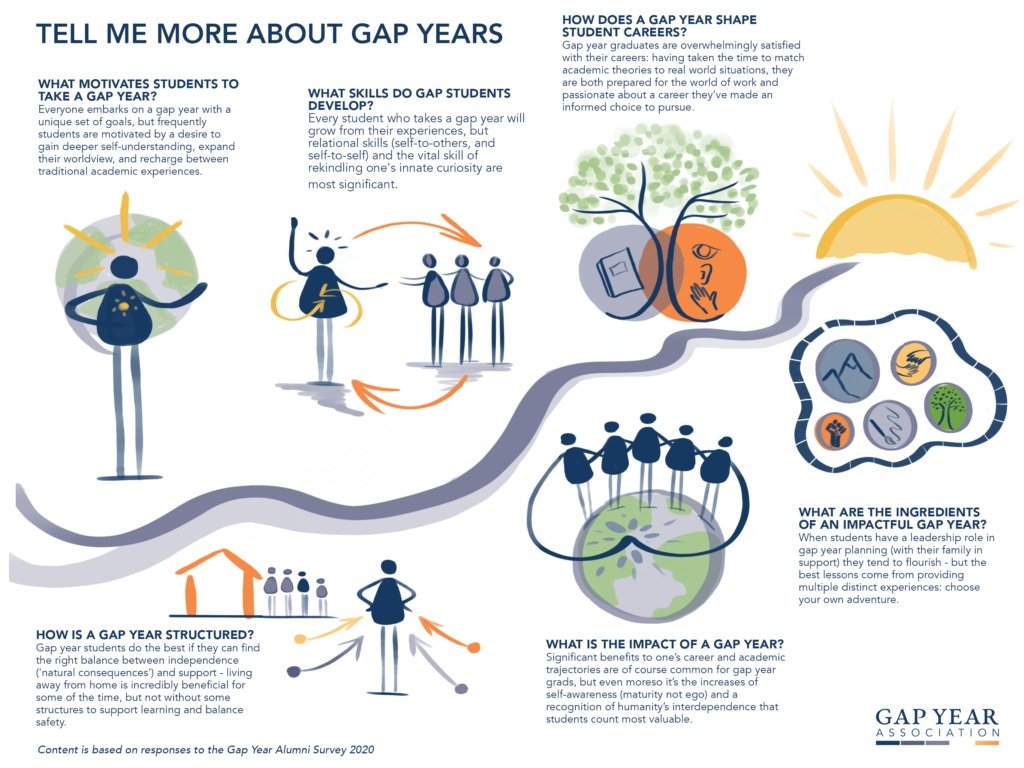How to Plan a Gap Year
By Lindsey Permar
What is a Gap Year?
A gap year is most simply a year dedicated to doing something purposeful outside of a traditional academic trajectory, usually taken before beginning college or work. The Gap Year Association suggests this time can be “a semester or year of experiential learning … in order to deepen one’s practical, professional, and personal awareness.”¹ Below are some tips on how to plan a gap year.
Why Take a Gap Year?
In 2020, the American Gap Association, together with the University of Pennsylvania, conducted a Gap Year Alumni survey, which asked students about their motivations for taking a gap year. The top responses from the 1,190 participants included wanting to:
Gain life experiences and grow personally (81%)
Travel and experience other cultures (70%)
Take a break and/or were feeling burnt out (35%)
Their motivations align with the outcomes – participants noted improvement in:
Cultural awareness (55%)
Communication (48%)
Self-direction (39%)
AmeriCorps alumni reported similarly positive outcomes in their 2015 survey, where students said that their gap year helped improve these skills:
Adapting to new situations (71%)
Responding to unexpected challenges (66%)
Working with people different from myself (66%)
A gap year before college can ultimately help save time and money by helping students arrive on campus with an invigorated sense of self and purpose.
Something Purposeful: What Does That Mean?
What is purposeful for one person may not be the case for the next, so it is an important question to ask: why am I taking a gap year? Some students simply feel burnt out from the mental weight of a Covid-limiting high school experience and want to use the time for a more in-depth exploration of personal and academic interests. Others may feel energized by the thought of a research project while working to fund their year.
To get the most out of your gap year, be honest about what you hope to gain from the experience. Despite there being an endless list of paid program options as well, there is no amount of time or money that can create a meaningful experience for you. Get in the right mindset that will help you maximize this time!
Gap Year: So, What Should I Do?
There is no universal “perfect Gap Year” plan. In fact, even the best plans can fall victim to unsuspected setbacks (like Covid). This is why having a guiding purpose can help you stay focused on the big picture, regardless of what may come your way. Here is a quick list of gap year options:
Take courses
Get an internship
Get a job
Pursue a project
Volunteer
Explore a new place
Multi-dimensional experiences can be the most enriching. A student interested in engineering could get an internship at a local engineering firm while pursuing a research project and maybe taking a photography course. Creating a personalized plan provides you with the creative and intellectual flexibility to pursue your passions.
Gap Year Association Venn Diagram. Gap Year Association,
https://www.gapyearassociation.org/what-is-a-gap-year-2/. Accessed 3 July 2023.
Take your time in crafting a plan – make a list of what you love and what your talents are. Take some space and revisit your list with fresh eyes, talk about your ideas with family, seek guidance from trusted mentors, and allow yourself the freedom to explore the myriad options in front of you.
Need more personalized guidance? Reach out to one of our counselors to help create a unique plan of action that’s right for YOU!
Additional Articles of Interest
Gap Year Resources, University of Pennsylvania, 2023
Resources for Planning Your Gap Year, Brown University, 2023
How a Gap Year Prepares Students for College, US News, 2022
Considering a Gap Year, Harvard University, 2021
Some college-bound students in the U.S. Are Thinking of Taking a Gap Year, NPR, 2020.
Gap Year Ideas for College Students, New York Times, 2020
Unprecedented Number of Students Are Taking a Gap Year. What Should They Do With the Time? EdSurge, 2020
The Rise of the Pandemic-Era Gap Year, BBC, 2020


